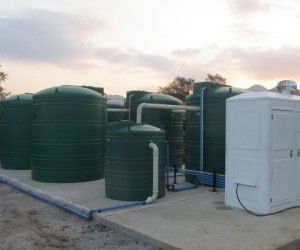The environmental footprint of world renowned tourist attraction, the Bourke’s Luck Potholes in Mpumalanga, has been taken to new level thanks to SewTreat’s supply of a biological waste water treatment plant for the Mpumalanga Tourism & Parks Agency.
The existing septic tank system servicing the main reception and bathroom facilities at Bourke’s Luck Potholes has been replaced with sustainable sanitation technology thanks to SewTreat. “This technology will ensure that from now on, only clean, recycled effluent is discharged into the Blyde River thereby helping to conserve and preserve the precious ecosystem if the Blyde River system,” enthused Theunis Coetzer, spokesperson for SewTreat.
The Bourke's Luck Potholes welcomes in excess of 1 million visitors annually – the majority of which are foreign tourists. According to Coetzer, the existing infrastructure was out-dated could not cope with the high volumes of effluent produced. “The old septic system was discharging substandard effluent into the Blyde River causing secondary contamination and pollution of this pristine river system,” said Coetzer.
Through the appointed consulting engineers for the project, SewTreat was contracted by the Mpumalanga Tourism and Parks Agency to design, construct and install a complete waste water treatment plant for all effluent generated by the current sanitation facilities at the Bourke's Luck Potholes site. The decision to appoint SewTreat was based on the ability of their products to treat waste water and sewage using environmentally friendly methods.
“Our motto is to treat nature with nature,” Coetzer explained. “All our plants make use of our proprietary strain of natural bacteria developed by our in-house team. The bacteria ensure that all waste is treated by a biological process resulting in a clean final effluent that is kinder to the environment.”
Biological wastewater treatment is an accepted practice used worldwide. The process involves confining naturally occurring bacteria at a very high concentration in the treatment process, whether it in plastic type, containerised type or civil constructed type treatment plants. From here this bacteria, together with some protozoa and other microbes (collectively referred to as activated sludge), are treated in an anaerobic and an aerobic process. They are then returned to the anaerobic phase to eliminate sludge accumulation and waste generation. Coetzer elaborated by saying: “In a nutshell, the bacteria digest all impurities and the wastewater is then cleansed. The treated wastewater or effluent can then be safely discharged to receiving waters – normally a river or the sea – or alternatively used for irrigation, flushing of toilets or general non-potable uses.”
After conducting a full assessment, SewTreat opted to supply a plastic, above ground type waste water treatment plant which would cope with the amount of waste to be processed daily, could be installed easily given the challenging access to the site and would be completed under a tight deadline and budget. SewTreat’s technology will now ensure that the Bourke's Luck Potholes and the Blyde river system are kept pristine and unpolluted at a staggering rate of 7.5 million litres per year.
Coetzer concluded by saying: “We hope that by offering wastewater management products that are cost effective, easy to install, simple to maintain and provide a green waste solution; we can help all of our precious local tourism and conservation sites move towards a greener future. Preventing further damage to the environment requires a fundamental shift in how tourism operations conduct their business and manage resources. Changing how you treat your wastewater to a method that results in reusable effluent is a major step towards sustainability where the long term beneficiaries will be South Africa’s nature, wildlife and resources.”












